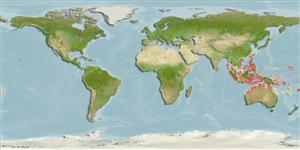>
Gobiiformes (Gobies) >
Gobiidae (Gobies) > Gobiinae
Etymology: Asterropteryx: Greek, a = with + Greek, sterros, -a, -on = consistent + Greek, pteryx = fin (Ref. 45335); atripes: Named for its conspicuouc black pelvic fin.
Environment: milieu / climate zone / depth range / distribution range
Sinh thái học
Biển Cùng sống ở rạn san hô; Mức độ sâu 10 - 25 m (Ref. 90102). Subtropical
Indo-West Pacific: Andaman Is., Brunei, Ryukyu Islands, the Philippines and Indonesia.
Bộ gần gũi / Khối lượng (Trọng lượng) / Age
Maturity: Lm ? range ? - ? cm
Max length : 2.2 cm SL con đực/không giới tính; (Ref. 44260)
Short description
Khóa để định loại | Hình thái học | Sinh trắc học
Các tia vây lưng cứng (tổng cộng) : 6 - 7; Các vây lưng mềm (tổng cộng) : 9 - 10; Tia cứng vây hậu môn: 1; Tia mềm vây hậu môn: 9; Động vật có xương sống: 26. This species is distinguished from its congeners by having the following combination
of characters: long, filamentous 3rd spine of 1st dorsal fin, distal tip usually over end of 2nd dorsal fin base when adpressed; almost separated pelvic fins, innermost (= 5th) segmented rays connected by rudimentary low membrane between bases, no frenum; 4-7 short spines on posterior margin of preopercle (uppermost spine usually just behind the cephalic sensory canal pore N); large eye, 32.3-35.8% of head length; enlarged haemal arches on 1st two caudal vertebrae; posterior margin of eye to caudal fin base has a distinct black band (indistinct in dark-phase individuals); black pelvic fin (vivid in dark phase individuals); many minute bright blue spots on head and body when live or fresh; distinct dark spots on head and body absent; iris entirely reddish-brown or dusky (bright white ventrally in pale-phase individuals) when alive or fresh, becoming entirely black in preservation, with no white transverse bar on middorsal surface; has a hovering habit (Ref. 44260).
Inhabits sheltered bays on sand, rubble and mud bottoms in 10-25 m (Ref 90102).
Life cycle and mating behavior
Chín muồi sinh dục | Sự tái sinh sản | Đẻ trứng | Các trứng | Sự sinh sản | Ấu trùng
Shibukawa, K. and T. Suzuki, 2002. Asterropteryx atripes, a new gobiid fish from the Western Pacific Ocean (Perciformes: Gobioidei). Ichthyol. Res. 49(3):274-280. (Ref. 44260)
IUCN Red List Status (Ref. 130435: Version 2024-2)
Threat to humans
Harmless
Human uses
Các công cụ
Special reports
Download XML
Các nguồn internet
Estimates based on models
Preferred temperature (Ref.
123201): 26.7 - 29.3, mean 28.7 °C (based on 1945 cells).
Phylogenetic diversity index (Ref.
82804): PD
50 = 0.5039 [Uniqueness, from 0.5 = low to 2.0 = high].
Bayesian length-weight: a=0.00724 (0.00339 - 0.01546), b=3.10 (2.92 - 3.28), in cm total length, based on LWR estimates for this (Sub)family-body shape (Ref.
93245).
Mức dinh dưỡng (Ref.
69278): 3.2 ±0.4 se; based on size and trophs of closest relatives
Thích nghi nhanh (Ref.
120179): Chiêù cao, thời gian nhân đôi của chủng quần tối thiểu là dưới 15 tháng (Preliminary K or Fecundity.).
Fishing Vulnerability (Ref.
59153): Low vulnerability (10 of 100).
Nutrients (Ref.
124155): Calcium = 320 [117, 1,108] mg/100g; Iron = 1.95 [0.71, 4.97] mg/100g; Protein = 18.1 [15.9, 20.1] %; Omega3 = 0.158 [0.045, 0.524] g/100g; Selenium = 15.8 [3.8, 55.1] μg/100g; VitaminA = 103 [17, 601] μg/100g; Zinc = 3.01 [1.41, 5.56] mg/100g (wet weight);
